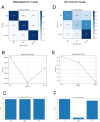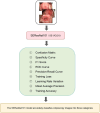Integrating SEResNet101 and SE-VGG19 for advanced cervical lesion detection: a step forward in precision oncology
- PMID: 40437403
- PMCID: PMC12121095
- DOI: 10.1186/s12885-025-14353-z
Integrating SEResNet101 and SE-VGG19 for advanced cervical lesion detection: a step forward in precision oncology
Abstract
Background: Cervical cancer remains a significant global health issue, with accurate differentiation between low-grade (LSIL) and high-grade squamous intraepithelial lesions (HSIL) crucial for effective screening and management. Current methods, such as Pap smears and HPV testing, often fall short in sensitivity and specificity. Deep learning models hold the potential to enhance the accuracy of cervical cancer screening but require thorough evaluation to ascertain their practical utility.
Methods: This study compares the performance of two advanced deep learning models, SEResNet101 and SE-VGG19, in classifying cervical lesions using a dataset of 3,305 high-quality colposcopy images. We assessed the models based on their accuracy, sensitivity, specificity, and area under the receiver operating characteristic curve (AUC).
Results: The SEResNet101 model demonstrated superior performance over SE-VGG19 across all evaluated metrics. Specifically, SEResNet101 achieved a sensitivity of 95%, a specificity of 97%, and an AUC of 0.98, compared to 89% sensitivity, 93% specificity, and an AUC of 0.94 for SE-VGG19. These findings suggest that SEResNet101 could significantly reduce both over- and under-treatment rates by enhancing diagnostic precision.
Conclusion: Our results indicate that SEResNet101 offers a promising enhancement over existing screening methods, integrating advanced deep learning algorithms to significantly improve the precision of cervical lesion classification. This study advocates for the inclusion of SEResNet101 in clinical workflows to enhance cervical cancer screening protocols, thereby improving patient outcomes. Future work should focus on multicentric trials to validate these findings and facilitate widespread clinical adoption.
Keywords: Cervical cancer; Cervical screening; Deep learning; HSIL; Image classification; LSIL; Medical imaging; SE-VGG19; SEResNet101.
© 2025. The Author(s).
Conflict of interest statement
Declarations. Ethics and consent to participate: Ethics approval for this study was obtained from the Clinical Ethics Committee of Wenzhou People’s Hospital (Approval No. 220211A). Informed consent was obtained from all individual participants included in the study. Consent for publication: Not applicable. Competing interests: The authors declare no competing interests.
Figures








References
-
- Su M, Shan S, Gao Y, et al. 2-Deoxy‐D‐glucose simultaneously targets Glycolysis and Wnt/β‐catenin signaling to inhibit cervical cancer progression. IUBMB Life. 2023;75(7):609–23. 10.1002/iub.2706. - PubMed
-
- Perkins RB, Wentzensen N, Guido RS, Schiffman M. Cervical Cancer screening. JAMA. 2023;330(6):547. 10.1001/jama.2023.13174. - PubMed
MeSH terms
Grants and funding
LinkOut - more resources
Full Text Sources
Medical
Research Materials

